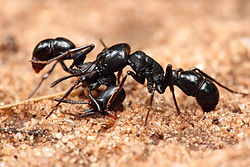Ponerinae, the ponerine ants,[2] is a subfamily of ants in the Poneromorph subfamilies group, with about 1,600 species in 47 extant genera, including Dinoponera gigantea - one of the world's largest species of ant. Mated workers have replaced the queen as the functional egg-layers in several species of ponerine ants. In such queenless species, the reproductive status of workers can only be determined through ovarian dissections.[citation needed]
| Ponerinae Temporal range:
| |
|---|---|

| |
| Fighting Harpegnathos saltator | |
| Scientific classification | |
| Domain: | Eukaryota |
| Kingdom: | Animalia |
| Phylum: | Arthropoda |
| Class: | Insecta |
| Order: | Hymenoptera |
| Family: | Formicidae |
| Subfamily: | Ponerinae Lepeletier, 1835 |
| Type genus | |
| Ponera Latreille, 1804
| |
| Diversity[1] | |
| 59 genera | |

Description and identification
editThey are most easily identified from other subfamilies by possessing a single-node petiole with a constriction before the second gastral segment.[3] They are rare examples of stinging ants.[4] In addition to the sting, they can also be characterized by a single segmented petiole and the constriction of the first and second segment of the gaster. They can also be identified[how?] by the shape of their head. Female workers have twelve segmented antennae, whereas male workers have 13 segmented antennae.[3]
Behavior
editThese ants typically nest in soil, forest litter, or rotting logs, and are predacious.[5] They primarily prey on isopods. They mostly live in small colonies of up to 200 workers. They can be found mostly in tropical environments, but have been found in southeastern Canada and New York.[citation needed]
Genera
edit- Platythyreini Emery, 1901
- Platythyrea Roger, 1863
- Ponerini Lepeletier de Saint-Fargeau, 1835
- Anochetus Mayr, 1861
- †Archiponera Carpenter, 1930
- Asphinctopone Santschi, 1914
- Austroponera Schmidt & Shattuck, 2014
- Belonopelta Mayr, 1870
- Boloponera Fisher, 2006
- Bothroponera Mayr, 1862
- Brachyponera Emery, 1900
- Buniapone Schmidt & Shattuck, 2014
- Centromyrmex Mayr, 1866
- †Cephalopone Dlussky & Wedmann, 2012[6]
- Cryptopone Emery, 1893
- †Cyrtopone Dlussky & Wedmann, 2012[6]
- Diacamma Mayr, 1862
- Dinoponera Roger, 186
- Dolioponera Brown, 1974
- Ectomomyrmex Mayr, 1867
- Emeryopone Forel, 1912
- Euponera Forel, 1891
- Feroponera Bolton & Fisher, 2008
- Fisheropone Schmidt & Shattuck, 2014
- Hagensia Forel, 1901
- Harpegnathos Jerdon, 1851
- Hypoponera Santschi, 1938
- Iroponera Schmidt & Shattuck, 2014
- Leptogenys Roger, 1861
- Loboponera Bolton & Brown, 2002
- Mayaponera Schmidt & Shattuck, 2014
- Megaponera Mayr, 1862
- Mesoponera Emery, 1900
- †Messelepone Dlussky & Wedmann, 2012[6]
Messelepone leptogenoides male - Myopias Roger, 1861
- Neoponera Emery, 1901
- Odontomachus Latreille, 1804
- Odontoponera Mayr, 1862
- Ophthalmopone Forel, 1890
- Pachycondyla Smith, 1858
- Paltothyreus Mayr, 1862
- Parvaponera Schmidt & Shattuck, 2014
- Phrynoponera Wheeler, 1920
- Plectroctena Smith, 1858
- Ponera Latreille, 1804
- Promyopias Santschi, 1914
- †Protopone Dlussky, 1988[6]
- Psalidomyrmex André, 1890
- Pseudoneoponera Donisthorpe, 1943
- Pseudoponera Emery, 1900
- Rasopone Schmidt & Shattuck, 2014
- Simopelta Mann, 1922
- Streblognathus Mayr, 1862
- Thaumatomyrmex Mayr, 1887
- incertae sedis
- †Afropone Dlussky, Brothers & Rasnitsyn, 2004
- †Eogorgites Hong, 2002
- †Eoponerites Hong, 2002
- †Furcisutura Hong, 2002
- †Longicapitia Hong, 2002
- †Ponerites Dlussky & Rasnitsyn, 2003
- †Taphopone Dlussky & Perfilieva, 2014
References
edit- ^ Bolton, B. (2015). "Ponerinae". AntCat. Retrieved 9 January 2015.
- ^ Schmidt, Chris (9 May 2013). "Molecular phylogenetics of ponerine ants (Hymenoptera: Formicidae: Ponerinae)". Zootaxa. 3647 (2): 201–250. doi:10.11646/zootaxa.3647.2.1. PMID 26295106.
- ^ a b "Ponerinae". AntWiki.
- ^ Hoffman, Donald R. (2010). "Ant venoms". Current Opinion in Allergy & Clinical Immunology. 10 (4): 342–346. doi:10.1097/ACI.0b013e328339f325. PMID 20445444. S2CID 4999650.
- ^ Schmidt, C.A.; Shattuck, S.O. (2014). "The higher classification of the ant subfamily Ponerinae (Hymenoptera: Formicidae), with a review of ponerine ecology and behavior". Zootaxa. 3817: 1–242. doi:10.11646/zootaxa.3817.1.1. PMID 24943802.
- ^ a b c d Dlussky, G.M.; Wedmann, S. (2012). "The poneromorph ants (Hymenoptera, Formicidae: Amblyoponinae, Ectatomminae, Ponerinae) of Grube Messel, Germany: High biodiversity in the Eocene". Journal of Systematic Palaeontology. 10 (4): 725–753. Bibcode:2012JSPal..10..725D. doi:10.1080/14772019.2011.628341. S2CID 83928415. – via Taylor & Francis (subscription required)
External links
edit- Media related to Ponerinae at Wikimedia Commons